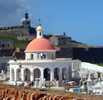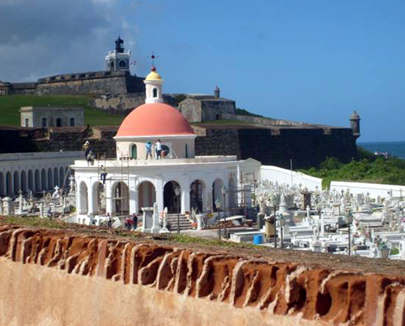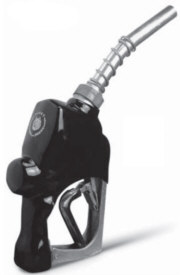 217 miles - 4-8 hours
217 miles - 4-8 hoursThis is an exotic road trip route. Some of the signs and services are similar to those in the US mainland, but Puerto Rico is a very different and enchanting place. Puerto Rico is a territory of the United States, and both English and Spanish are the official languages. A knowledge of Spanish is essential if you're exploring off the beaten path. This journey begins in a port city that has been welcoming visitors since the 1500s. The route meanders around the island past romantic beaches, and has stops to sample the food of the region. It ends at the site of the largest radio telescope in the world. (Edit: September, 2018 - Due to changes in roads after the hurricanes, the original route designed by Michael Roth of 189 miles is now 217 miles long. And the route actually ends at the Arecibo Lighthouse Historical Park instead of the Arecibo Observatory.)
Here are some highlights along the route.
San Juan (Starting point)
The number one attraction here is the iconic El Morro. The fort has incredible views of the coast and has played the important role of defending the harbor since it was created in the 1500s all the way through the end of World War II. San Juan is the point of entry for thousands of tourists who arrive each year by cruise ship. Thus, there scores of restaurants, shops, and other travel services. Consider visiting the Cathederal of San Juan Bautista, the second oldest Cathederal in the Western Hemisphere and the final resting place of Puerto Rico explorer Ponce de Leon. There are several small museums, including Museo de las Americas (Museum of the Americas). While not right in Old San Juan, a tour of the Bacardi Rum factory is nearby and very popular.
El Yunque National Forest (mile 29)
This is the only tropical rain forest in the US Forest Service system and one of the most scenic places on the entire island. There are several miles of hiking trails and a handful of waterfalls, including the incredible La Mina Falls. La Mina Fall is a 35-foot waterfall with swimming allowed in the pool at the bottom. The falls are accessed by one of two hiking trails, La Mina Trail or Big Tree trail. Each trail is paved, somewhat steep, and about 3/4 of a mile in length. One trail starts above the falls, the other starts below, and you can make a full loop by taking a one-mile walk along the main road through the park. La Coca Falls, which can be seen from the main highway, is the other major waterfall in the park, . There are also several hiking opportunities to hike up into the mountains, including the walk to the Mt. Britton viewing tower which offers views of the entire Northeast corner of the island. You can continue all the way up to the forest's namesake, El Yunque. At 3500 feet, it's one of the highest points in all of Puerto Rico.
Fajardo (mile 37)
Fajardo is the main city in northeast Puerto Rico. It has two of the best swimming beaches on the island: Luquillo Beach and Seven Seas. Nearby is a bioluminescent bay, where you can have the unique experience of watching tiny organisms actually cause the water to glow. Fajardo is also the ferry port for people looking to continue onto Vieques and Culebra, which are two small islands less than 20 miles away with stunning and less-visited beaches.
Guavate (mile 91)
Guavate is a small mountain town that's famous for one thing: Lechoneras. The town is filled with cafes that serve Lechon, a whole slow-roasted pig that is one of the most juicy, tender, and flavorful meat dishes that you'll ever find. These places also serve plenty of other Puerto Rican side dishes worth sampling, and on weekends many of the places also have live music. This can also be an easy day trip from San Juan, and while you're in the area, you may want to visit Bosque Estatal de Carite, a mountain preserve that's located right along the Ruta Panoramica, the scenic drive across the mountains that run east-west through the middle of the island.
Ponce (mile 140)
Ponce is the second-largest city in Puerto Rico. Plaza de las Delicias is the town square in the center of town that is certainly worth a stop. Some of the top attractions include Parque de Bombas, the brightly colored historic Fire Station that has been turned into a museum and tourist center. It stands in stark contrast to the Ponce Cathederal immediately behind the building. If you're looking for a good treat, King Ice Cream serves a tropical-flavored variety. Another very popular stop is the Ponce Art Museum, a world-class facility. Be aware, however, that it is currently closed as part of a major renovation project. It is currently scheduled to reopen -- and celebrate its 50th anniversary -- in November, 2010.
Arecibo (mile 189)
The Arecibo area is home to two of the most popular tourist attractions in Puerto Rico. Río Camuy Cave is one of the largest cave systems in the world and features an underground river. Also very nearby is the Arecibo Observatory, which features the world's largest radio telescope and a center open to the public that focuses on space exploration. The two sites are often visited together, but visit the caves first, since there are a limited number of spaces for cave tours. These sites are typically closed on Monday and Tuesday. Within the city of Arecebo is a lighthouse that is open for exploration, and nearby there are two fantastic beaches: one that features great calm water for swimming and another on the other side of the lighthouse that features fantastic waves.
Things to know about traveling in PR: Puerto Rico is a territory of the United States, so passports are not needed for American citizens for travel between PR and the US mainland. The US dollar is also the official currency, so you don't need to worry about changing money. The mail is delivered by the US Postal Service, and the phone system is the same, so your US cell phone may work. Puerto Ricans also love their chain stores, and you'll have no problem finding Walmart, McDonalds, or any of the other big American franchises if you are in a major city. There are, however, minor differences. Speed limit signs and speedometers are in miles per hour, but distances are measured in kilommeters. There is also, in general, a more laid-back atmosphere – but that's why you go to a Caribbean island in the first place!

San Juan Cemetery and El Morro in the background





